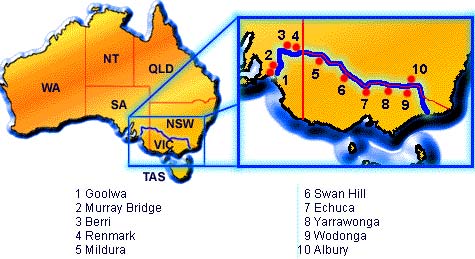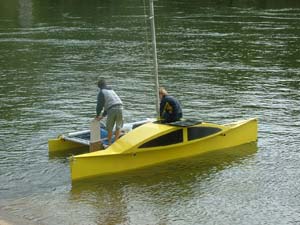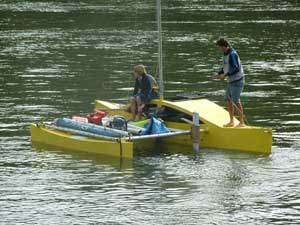|
Murray River Trip
by James Francis
I don’t really know why I wanted to make a proa, or a second proa, probably because it was a bit weird. If you don’t know what a proa is, it is a double ended sailing boat that looks like a trimaran missing an outrigger on one side. An ‘Atlantic Proa’ always keeps the outrigger to leeward, and a ‘Pacific Proa’ always keeps the outrigger to windward. My boat is a Pacific Proa. Instead of tacking or gybing, it ‘shunts’ which means that it swaps bow for stern and flies the sail round to the other end of the boat with a continuous mainsheet. ‘Shunting’ is good for scaring people fishing on the ends of wharfs by sailing full speed towards them, then slamming on the brakes at the last minute.
The first proa I made was 16ft, the main hull was symmetrical, and for steering it just had a centerboard at each end. The idea was that it would be like a windsurfer, only that it steered by moving the centre of lateral resistance in relation to the sail, rather than the sail in relation to the centre of lateral resistance. The only problem was it didn’t really work.
The second proa, is 20ft and I designed it to go cruising. The leeward side of the main hull is fairly straight and the windward side is curved, so it is like half a hull. The idea was that this would reduce leeway (like a wing on its side) and make the boat always want to bear away, which is good because it balances out the weather helm you get from having the centre of lateral resistance in the middle of the boat (because it is double ended). It has a rudder at both ends which are linked up with cross cables so you can steer with either the front or back tiller.
Anyway, a year later the second proa was still in the yard killing the grass, and it had only been sailing once. My friend Lachie Paramor who I went to school with and also sails 12 foot skiffs said “Why don’t take your proa for a cruise up the coast?”, I didn’t think it would be strong enough, so as a bit of a joke I said “We should take it down the Murray river”
“Well let’s do that then” he said.
So a month after that my dad and uncle had dropped us down to Yarrawonga near Albury and we were sailing (with a bit of help from a 5hp outboard) for Goolwa near Adelaide, in southern Australia, which was about 2000 km’s away.
We didn’t do very much planning, and all we knew about the Murray was that it was 2000 kilometers long and people kept making jokes like “hope your boats got wheels on it”.

Half an hour into the trip, we hit a snag and broke that fancy linked rudder system that I was talking about before.
The first four days we didn’t see a single boat on the river. The river was quite interesting because every few K’s we’d see these hobo camps with one or two people living permanently in a rusty old caravan, no sign of a car, with their junk scattered all around, and they’d clearly disappeared off the system. There were some real nice beaches all along the way, and not seeing anyone apart from the hobos, made us really feel like we were in the middle of nowhere (and a little scared that a hobo would come and murder us in the middle of the night).
We had to do about 110km/ day to get to Goolwa in time for our lift home, so we were in a bit of rush, but we still found time to stop and have a look at the old towns, that we’d normally come across each day. On the third day we got to Echuca , where there were big wharves and heaps of slipways, paddle steamers and a shop that let us spend all our money on homemade fudge.
On the fifth day we reached Swan Hill, where we put up our tent (as opposed to sleeping one in each end of the boat) in the caravan park, did our washing, and had the first of our once-per-week showers. We met Pat and Mel here, who are a retired couple on a caravanning holiday. They spend a few hours taking photos of us and the boat and were ready to sign some adoption papers. They made us sandwiches, gave us lots of food, and ended up following us down the river to Mildura.

After Swan Hill we started going through locks. There are 12 locks on the Murray, which are normally about 80km’s apart. Over the next four days we found the river in between the locks fairly boring because every bend seemed to look exactly the same. So we amused ourselves by playing with the water pistol that John Whitty had given me for my birthday. It kind of looks like a massive syringe, so I brought it along to bail the boat out with, but we also found it was good for doing drive-by shootings on the cows that stand beside the river. When we saw a pack of bulls we would pull in and wave a red shirt, but nothing ever seemed to happen.
On the tenth day we pulled into Mildura. Mum and dad (I mean Pat and Mel) came and picked us up and drove us back to their caravan and cooked us a roast dinner and gave us more food for the next few days. When we left Mildura, we both had a rash on hands and feet that was unbearably itchy. We also noticed that our hands and feet were swelling up and the bones were beginning to hurt.
After Mildura it would be 3 days until we could get any fuel, so we took 40 litres which should have been heaps. The problem was a 20 knot westerly had come up, which seemed to make us use double the fuel we had been using up until then. The breeze against the one and a half knot current made a sharp annoying chop that drenched us and slowed us down more because the outrigger was going under water and leaking through the hatch. We had to keep pumping it out with the water pistol. A day later it was clear that we weren’t going to have enough fuel, so we did all the tricks: tipping up the tank to get the last drop out, then disconnecting the fuel hose, poking it through the top of the tank and holding in a corner. We just made it to a lock, and conned the guys there into giving us some fuel. After a couple more days, we’d crossed the South Australian border and reached Renmark.
Renmark is like a mini city, so we stocked up on food, and treated ourselves to a Pizza for dinner. The ‘disease’ we caught at Mildurra was beginning to seem like a problem, my feet and hands were massive and felt like they were broken and it was keeping me awake at night.
Apart from the disease, the next few days were awesome. We’d already done 1500km and had only 500km to go. The South Australian part of the river was real nice. One minute we’d be going through a forest, the next minute a big empty plain, and the next minute some big high cliffs on both sides of the river. We had a good routine, we’d get up about 7.00am, push off, make some breakfast, swap the helm every few hours, cook pasta and pesto for lunch, then we’d pull in at about 7.00pm, tie up to a bank and have pasta and pesto for dinner. By the end of the trip I’d probably eaten my body weight in pesto sauce. Sleeping in the boat was good, because it was dry and fairly warm, but it was getting a bit uncomfortable. Because the boat had an asymmetric hull, you could only sleep on one side. Sleeping on your side meant that you had to straighten your feet, but because of the disease I couldn’t straighten my feet. So I think my back is now twisted for life.

One night we stopped in at a little town called Morgan, planning to get a meal in the pub. The walk up the hill to the pub just about killed us because our feet seemed to be stuck at right angles. Two days later we decided to stop in at Mannum and see a doctor. He suspected it was Ross River virus which we both must have caught from the water, so he did a blood test( that we’re still waiting for the results on), and gave us some drugs.
The second last day of the trip was a big day because we had to catch up on some miles if we were to finish on schedule. So we started out at 6:30 in the morning and got into Wellington at 11:30 that night. The following day we had to cross Lake Alexandrina.
Seeing as it was 40km across the lake, and we couldn’t see where we were going, we realized that we might actually have to navigate. I don’t know much about navigation, but Lockie told me just to follow 248 degrees on the GPS. I thought I was doing a pretty good job staying on course, but once we’d decided to put the kite up, and the outrigger was flying nicely, I lost interest in the course and paid all my attention to the speed, which was beginning to show 8 – 9 knots. I let us run away from our tight angle, because I was so excited about seeing 9 knots. Half an hour later the north westerly had turned into a south westerly and we were still going with the kite. Eventually we dropped the kite but by then I had no idea which way I was meant to be going. We dropped the main and Lockie made a guess as to where Goolwa was, so we started motoring straight into the 25 knots and sharp waves. The mast isn’t supported that well when the sail isn’t up, because the stays are only on the windward side, going out to the outrigger. The mast soon broke and landed in the water after all that whipping around, but that didn’t really matter, we’d be at Goolwa in a few hours.
At about 5:30pm we got into Goolwa. According to the tourist centre we were the only people to have done the trip since march, which probably explains why we thought it was a bit cold. We stayed in a motel that night, had a shower, went to the pub and my dad and uncle came down to pick us up the next day.
|

